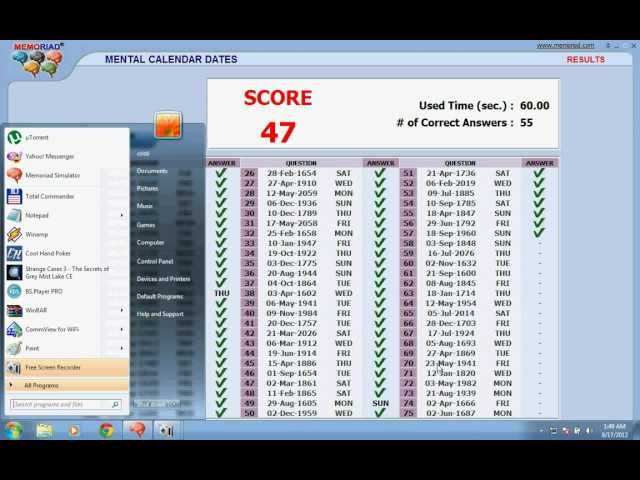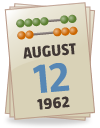
Um diesen Inhalt anzuzeigen muss eine Verbindung zu Youtube / Google hergestellt werden. Dabei werden von Ihrem Browser eventuell persönliche Daten übertragen und ausgewertet. Wollen Sie dennoch fortfahren?
Instructions: How to calculate weekdays
The Gregorian calendar, which is now used worldwide (named after Pope Gregory XIII) was created at the end of the 16th century as a result of a calendar reform. Therefore the calculation of weekdays is possible from the 16th century on.
The weekday calculation is an algorithm allowing to calculate the weekday of any given date. To make this calculation, one "only" needs to learn a couple of numbers by heart: 12 and 28. Then you can make this calculation in your head.
The calculation
You need the following five numbers for the calculation:
- Day's digit
- Month's digit
- Century's digit
- Year's digit
- Leap-year correction (possibly)
Day's digit
7 will be substracted from the day's digit until it is no longer possible. Only the carry-over will be needed. It will always be between 0-6.
- Example of 13: 13-7 = carry-over 6
Month's digit
These are the monthly figures that you have to remember:
February = 2
March = 2
May = 0
June = 3
August = 1
September = 4
November = 2
December = 4
- Example of July = 5
Century's digit
The basic values for the centuries are the following:
- 0/7 for all years starting with 16, 20, 24.
- 1 for all years starting with 19, 23, 27.
- 3 for all years beginning starting with 18, 22, 26.
- 5 for all years starting with 17, 21, 25.
- Example of 19th century = 1
The following formula is the formula for the century digit: (3-(century mod 4)) x2 + 1.
Year's digit
28 will be substracted from the year's digit until it is no longer possible. Only the carry-over will be needed. It will always be between 0-28. Then we still need the centuries' basic values.
| J | 0 | 1 | 2 | 3 | 4 | 5 | 6 | 7 | 8 | 9 | 10 | 11 | 12 | 13 | 14 | 15 |
| Z | 0 | 1 | 2 | 3 | 5 | 6 | 0 | 1 | 3 | 4 | 5 | 6 | 1 | 2 | 3 | 4 |
| J | 16 | 17 | 18 | 19 | 20 | 21 | 22 | 23 | 24 | 25 | 26 | 27 | 28 |
| Z | 6 | 0 | 1 | 2 | 4 | 5 | 6 | 0 | 2 | 3 | 4 | 5 | 0 |
- Beispiel 72/28 = 2 Rest 16 = 6
Optionally, you can also calculate these numbers on your own by dividing the accumulated dates by four. Only the remainder is important which you will get after having divided the total sum by 7.
- Example 72: 72/4 = 18, 72 +18 = 90, 90/7 = 12 remainder 6
Leap year correction
Up to present, we have added the leap day to the whole year. This means that our calculation is only valid from 1 March on. If the date falls within a January or February of a leap year, a 1 must be deducted.
Leap years are all years that are divisible by 4. Century years are only considered leap years if they are divisible by 400.
Determine the day of the week
1 = Monday
2 = Tuesday
3 = Wednesday
5 = Friday
6 = Saturday
7 = Sunday
Example
We are looking for July 13th, 1972
Day's digit = 6
Month's digit = 5
Century's digit = 1
Year's digit = 6
Sum = 18.
From this sum, you have to deduct 7 as often as possible. Result: 18/7 = 2 remainder 4.
Now you have to determine the day of the week.
Therefore, July 13th, 1972 was a Thursday.
How does the number get to your brain?
To reach our goal, we are using a story based on the Number-Shape System (Association)
| Month | Association | Value/Number Image | Story |
|---|---|---|---|
| January | Jaguar | 6 - dice | The Jaguar plays dice with you. |
| February | Feather | 2 - Swan | The swan is losing a feather. |
| March | Mercedes | 2 - Swan | The Mercedes Star ist replaced by a swan. |
| April | Apricot | 5 - Hand | The apricots in your hand. |
| May | Maypole | 0 - Egg | An egg lies on the Maypole. |
| June | June bug | 3 - Trident | The June Bug has been impaled by the trident |
| July | Secret Santa | 5 - Hand | I unwrap the gifts with my hands. |
| August | Eye | 1 - Tree | The tree pricks your eye. |
| September | Hat | 4 - Chair | The hat lies on the chair |
| October | Octopus | 6 - dice | The octopus plays dice with his eight arms. |
| November | Advent wreath | 2 - Swan | A swan sits on the Advent wreath |
| December | Santa Claus | 4 - Chair | Santa Claus is sitting on the chair. |
28-digit number
| J | 0 | 1 | 2 | 3 | 4 | 5 | 6 | 7 | 8 | 9 | 10 | 11 | 12 | 13 | 14 | 15 |
| Z | 0 | 1 | 2 | 3 | 5 | 6 | 0 | 1 | 3 | 4 | 5 | 6 | 1 | 2 | 3 | 4 |
| J | 16 | 17 | 18 | 19 | 20 | 21 | 22 | 23 | 24 | 25 | 26 | 27 | 28 |
| Z | 6 | 0 | 1 | 2 | 4 | 5 | 6 | 0 | 2 | 3 | 4 | 5 | 0 |
We are using a story with key words based on the Master System (Linked with the Master Code).
We take dynamite(123) to fish for salmon(560). Then we set a timer (134) to go to the Lighthouse(561). There we see how a number girl(234) is celebrating her wedding (601). We climb down the chicken ladder(245) and ride away with the bullock(602). And the lesson(345) in the story: memory training needs a lot of imagination.
The 0 and 28 are not in it, they are both 0.
Weekday
| Day | 0 | 1 | 2 | 3 | 4 | 5 | 6 | 7 |
| Wert | Sunday | Monday | Tuesday | Wednesday | Thursday | Friday | Saturday | Sunday |
This is very simple, isn't it?
Enjoy the calculating.
practice mental arithmetic: Calendrical calculation - calculation of weekdays
Hier geht es darum, so schnell wie möglich den Wochentag zu einem Datum, im Kopf zu errechnen. Auf der Grundlage des weltweit angewendeten Gregorianischen Kalenders (benannt nach Papst Gregor XIII.). Dieser wurde Ende des 16. Jahrhunderts durch eine Kalenderreform eingeführt.
There are different disciplines:
- Weekdays - these are all years beginning with 1600 - 2099.
- Current century - as the name implies, only data from the current century.
- Current year - as the name suggests, only data from the current year.
There are two different lengths, 1 minute and 5 minutes. The better you get, the higher will be your level.
These are the different levels:
| Level | 5 min | Addition | Century | Addition | Year | Addition | 1 min | Addition | 1 min, year | Addition |
|---|---|---|---|---|---|---|---|---|---|---|
| 1 | 10 | 0 | 10 | 0 | 10 | 0 | 2 | 0 | 2 | 0 |
| 2 | 20 | 0 | 20 | 0 | 20 | 0 | 4 | 0 | 4 | 0 |
| 3 | 30 | 0 | 30 | 0 | 30 | 0 | 6 | 0 | 6 | 0 |
| 4 | 40 | 0 | 40 | 0 | 38 | 2 | 8 | 0 | 8 | 0 |
| 5 | 50 | 0 | 50 | 0 | 48 | 2 | 10 | 0 | 10 | 0 |
| 6 | 60 | 0 | 60 | 0 | 58 | 2 | 12 | 0 | 12 | 0 |
| 7 | 65 | 5 | 65 | 5 | 68 | 2 | 13 | 1 | 13 | 1 |
| 8 | 70 | 10 | 70 | 10 | 76 | 4 | 14 | 2 | 14 | 2 |
| 9 | 80 | 10 | 80 | 10 | 86 | 4 | 16 | 2 | 16 | 2 |
| 10 | 90 | 10 | 90 | 10 | 96 | 4 | 18 | 2 | 18 | 2 |
| 11 | 115 | 10 | 115 | 10 | 140 | 10 | 24 | 2 | 24 | 2 |
| 12 | 140 | 10 | 140 | 10 | 190 | 10 | 28 | 2 | 28 | 2 |
| 13 | 165 | 10 | 190 | 10 | 240 | 10 | 36 | 4 | 36 | 4 |
| 14 | 190 | 10 | 240 | 10 | 290 | 10 | 46 | 4 | 46 | 4 |
| 15 | 240 | 10 | 290 | 10 | 340 | 10 | 56 | 4 | 56 | 4 |
| 16 | 290 | 10 | 340 | 10 | 390 | 10 | 76 | 4 | 76 | 4 |
| 17 | 340 | 10 | 440 | 10 | 440 | 10 | 84 | 6 | 84 | 6 |
| 18 | 390 | 10 | 490 | 10 | 490 | 10 | 110 | 10 | 110 | 10 |
| 19 | 440 | 10 | 540 | 10 | 590 | 10 | 130 | 10 | 130 | 10 |
| 20 | 500 | 0 | 590 | 10 | 690 | 10 | 160 | 0 | 160 | 0 |
 Menü
Menü
